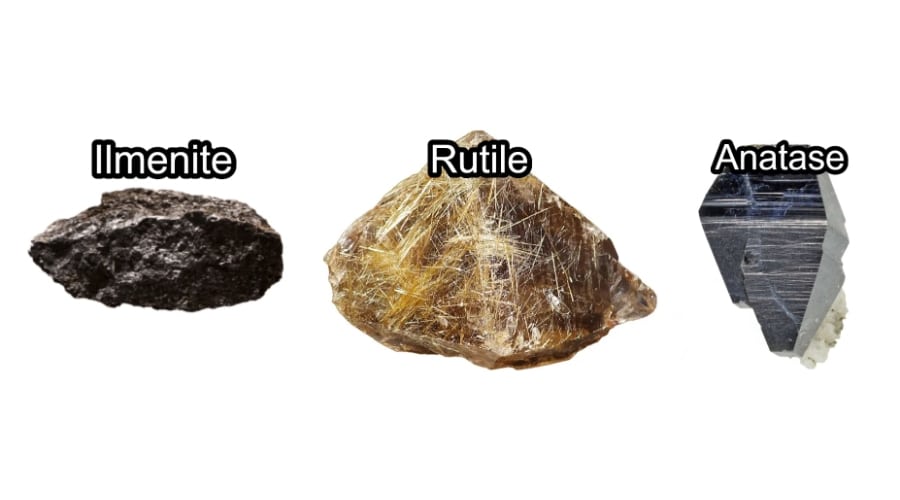Titanium metal plays an important role in many industries. From titanium ore to various finished products, it must go through a series of processing. Among them, what processes are required from mining to producing finished products? This article will tell you, help you increase your understanding of titanium, and better choose the right titanium products for your project.
Commonly used titanium ores
Titanium is the ninth most abundant element in the earth’s crust and is widely found in a variety of ores. The following are several commonly used titanium-containing ores:
– Ilmenite: This is the most common titanium-containing ore, and its main component is ferrous metatitanate (FeTiO₃). Ilmenite is distributed in large quantities in many regions around the world, with large reserves and low mining costs. It is usually one of the main sources of raw materials for titanium production and occupies an important position in the titanium industry. Its appearance is generally black or black-gray, with a metallic luster and high hardness.
– Rutile: The main component of rutile is titanium dioxide (TiO₂). It has a high titanium content and relatively few impurities. It is a high-quality raw material for producing high-quality titanium products. However, rutile is relatively rare in the earth’s crust and is not as widely distributed as ilmenite, so its price is usually higher. Rutile has a high refractive index and is also used in optics.
– Anatase: Anatase is also a mineral form of titanium dioxide, and its purity and crystal structure are different from rutile. Anatase also has a certain reserve in nature and can be used as a raw material for titanium production, but generally requires more complex processing to improve the extraction rate and product quality of titanium.

Titanium Ore Concentration
The first step in titanium production is to concentrate titanium from its ore. The concentration method for different ores will vary, but the general idea is to crush and grind the ore into a fine powder, increase the contact area between the ore and subsequent reagents, and then perform corresponding treatment to remove impurities. Taking ilmenite as an example, the common magnetic separation method is to use the difference in magnetic properties of ilmenite and gangue minerals to separate them. Some other physical and chemical beneficiation methods are also widely used to increase the content of titanium in concentrates.
Conversion to Titanium Tetrachloride (TiCl₄)
The next step is to convert the titanium ore into titanium tetrachloride (TiCl₄), a volatile compound that is easy to purify. For titanium-containing ores such as ilmenite, a series of pretreatments are usually carried out before the chlorination reaction. In large steel reactors, at temperatures of about 1,000°C, in the presence of chlorine and carbon, the titanium content of the ore reacts with chlorine to produce titanium tetrachloride.
For example, the reaction of ilmenite is as follows:
FeTiO₃ + 3Cl₂ + 3C → TiCl₄ + FeCl₃ + 3CO
The resulting TiCl₄ is a light, colorless liquid with high reactivity.
Purification of Titanium Tetrachloride
To ensure high-quality titanium, TiCl₄ must be purified. Usually, distillation is used to separate impurities based on their boiling points. Pure TiCl₄ is essential for the next step. Because even trace amounts of impurities may affect the quality and performance of subsequent titanium products.
Kroll Process: Converting TiCl₄ to Titanium
Developed by metallurgist William J. Kroll in the 1940s, the Kroll process is the most common method for producing titanium today. Here’s how it works:
1. Reduction: Pure TiCl₄ reacts with magnesium (or sodium) in a large steel reactor at temperatures around 800–850°C. The magnesium reduces titanium tetrachloride to elemental titanium:
TiCl₄ + 2Mg → Ti + 2MgCl₂
2. Formation of Titanium Sponge: The reaction produces a porous, spongy form of titanium, called titanium sponge, mixed with magnesium chloride (MgCl₂).
3. Separation and Cleaning: The magnesium chloride is removed by leaching (using water or a chemical solvent), leaving behind the titanium sponge.
Smelting and Alloying
Titanium sponge is not yet in a usable state. It is very porous and brittle. To make usable titanium, the sponge needs to be melted and alloyed with other metals, such as aluminum, vanadium, or molybdenum, depending on the desired properties. This is typically done through one of two methods:
– Vacuum Arc Remelting (VAR): Melting high-purity titanium electrodes under a high vacuum to produce a pure, uniform titanium ingot.
– Electron Beam Cold Hearth Melting (EBCHM): A more advanced method that further purifies titanium by removing impurities and inclusions.
Forming and Processing
Once the titanium is melted and refined, it is cast into ingots and then processed into a variety of shapes and forms. Titanium can be forged, rolled, extruded or machined into parts for aerospace, automotive, medical and other industries.
Why is the process so complicated?
Titanium’s high reactivity makes its production difficult. It reacts easily with oxygen, nitrogen and hydrogen at high temperatures, which weakens the metal’s properties. To produce high-quality titanium, the entire process must be carried out under controlled conditions, often using expensive equipment and an inert atmosphere such as argon. This complexity drives up the cost of titanium, making it more expensive than steel.
Future Innovations in Titanium Production
Researchers are constantly working to improve the efficiency and cost-effectiveness of titanium production. Emerging methods, such as the Fray-Farthing-Chen (FFC) Cambridge process, aim to produce titanium directly from oxide ores, without the need for the Klauer process. If these innovations are successful, they could revolutionize the industry, making titanium more affordable and accessible.
Daxun Alloy Co., Ltd. provides high-quality titanium to customers around the world. We offer a variety of grades of titanium to meet the needs of various projects. If your project requires titanium, Daxun Alloy Co., Ltd. is your best choice. Please contact us immediately and we will provide you with the best price and service.
Reference Links:https://kyocera-sgstool.co.uk/titanium-resources/titanium-information-everything-you-need-to-know/titanium-production-processes/
https://www.alltialloys.com/blog-posts/how-is-titanium-made-an-insight-into-the-production-process

